
This title sounds rather devote, but it concerns nothing more than
computing complex roots of the number 1. The roots of unity pop up in
the context of Discrete Fourier Transform. Once you know what they are,
they simplify the concept of DFT.
Let us start from the assumption that root extracting is the inverse
process of computing a power. The square root of 1 is 1 because 1*1=1.
But -1*-1 is 1 as well, so -1 is also a square root of 1. There
are two square roots of 1. If we take the cube root of 1, then -1 is
not a solution because -1*-1*-1=-1. So the cube root of 1 has only one
solution amongst the real numbers. But now let complex numbers enter
the scene. On the complex plane, there exist three unique points of
which the cube is 1. I have plotted these:
 |
How does that work? First we have to recognise that e(i2pi)
equals e0, because the complex exponentials are periodic
modulo 2pi. Further, e0 equals 1. Let us then compute the
cube of the first cube root of 1:
 |
The other complex cube root of 1 is (ei2pi/3)2,
and the cube of that will give ei4pi, which equals 1 again.
The third point (ei2pi/3)3 is on the positive
real axis. It is our familiar number 1 of which the cube is also 1.
The integer complex roots of unity seem to divide the unit
circle in equal intervals. How come? As we have seen earlier, the
logarithms of
complex exponentials on the unit circle are angles on the iy-axis. And
root-extracting of a number is equivalent to division of it's
logarithm.
Let us take a look at the three points again. All cube roots of 1
can also be defined as powers of the negative
interval e-i2pi/3:
 |
But obviously, the points can not all be defined as powers of ei2pi,
because these powers will never be something else than 1.
In order to further illustrate the pattern of roots of unity, I turn
to a next example: the 8th roots of unity. All points are
depicted here as positive powers of the first interval, being ei2pi/8.
That interval can be denoted the primitive 8th root of unity.
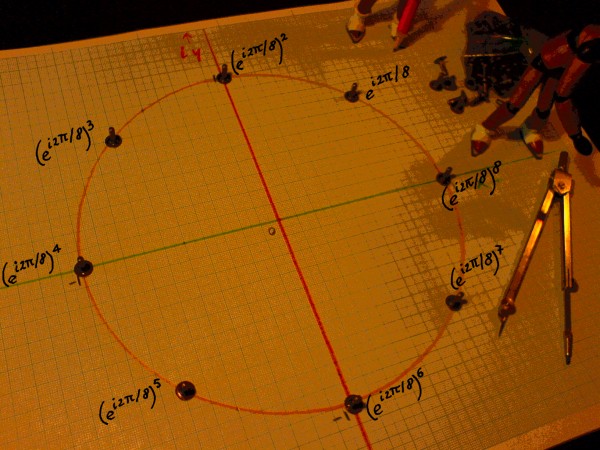 |
All points can also be described as negative powers of the primitive
8th root of unity.
 |
Complex exponentials have infinitely many aliases because of their
periodic character. Aliases can be a nuisance, but sometimes they can
be exploited to reduce the amount of computations. Anyway it is a good
thing to identify aliases. If we use n for the nth root and
k for the kth power, both being positive non-zero integers,
the following identity holds:
 |
Here is an example that can be checked with the preceding
illustrations.
 |
Below, the powers of (ei2pi/8)2 are illustrated. 4 unique points on the complex plane are visited twice. Therefore, these points can also be described as 4th roots of unity. Instead of (ei2pi/8)2, write (ei2pi/4). Because (ei2pi/4) is the square of (ei2pi/8), it must be the case that (ei2pi/8) is the square root of (ei2pi/4).
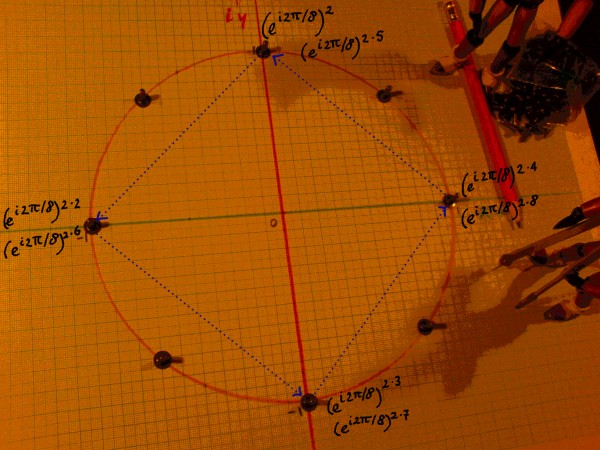 |
And down here, the powers of (ei2pi/8)3 are
illustrated.
It ends in 1 again, proving itself to be an 8th root of
unity. These powers happen to alias all powers of the primitive root ei2pi/8,
but they appear in a different order.
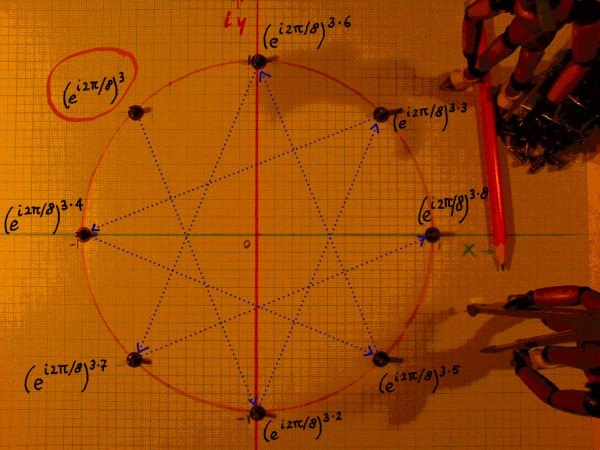 |
The successive powers of an nth root of unity describe
discrete
points of a complex sinusoidal function. A convention, or maybe a just
a lazy habitude, is to specify such a series by naming the first
interval of it. Let me plot the sinusoids of ei2pi/8 in the
real plane:
 |
And here is the series of the next root, (ei2pi/8)2:
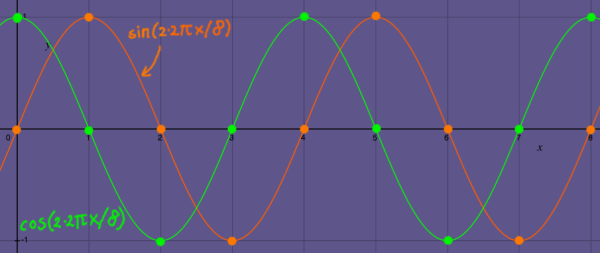 |
Now let me try some trick with the roots of unity. Because (ei2pi/8)*(ei2pi/8)2=(ei2pi/8)3,
it should be possible to compute the next complex pair of sinusoids
from the two preceding pairs:
(cos(2pix/8)+isin(2pix/8)*(cos(2*2pix/8)+isin(2*2pix/8)
=(cos(3*2pix/8)+isin(3*2pix/8)
My plotter gives the real output, that is the cosine, of 3*2pix/8 indeed. It does not output
imaginary numbers on the real plane of course, therefore the sine part
in the plot is computed separately to complete the picture.
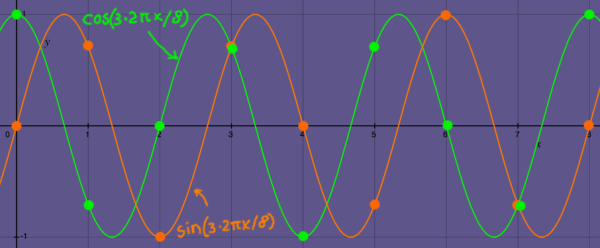 |
In fact, all 8th roots of unity, apart from the primitive
root, can be
computed as a product of two others. Of course, a similar rule holds
for other nth roots.
We can use this to our advantage. We multiplied the powers of the
primitive 8th root with those of the primitive 4th
root and obtained a third series. They are pictured below. But when we
take the square root of the 8th root, we can go one step
further, that is, to the 16th root.
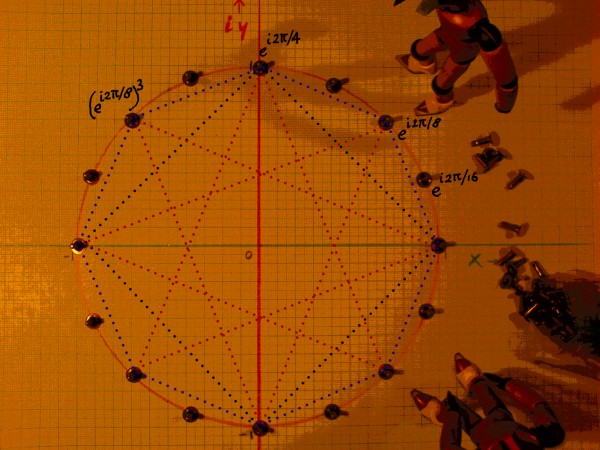 |
I multiply the three series that we had until now, with the series
of the 16th primitive root. From this multiplication three
new frequencies result. Together with the old frequencies and the 16th
primitive root, this gives already seven different frequencies.
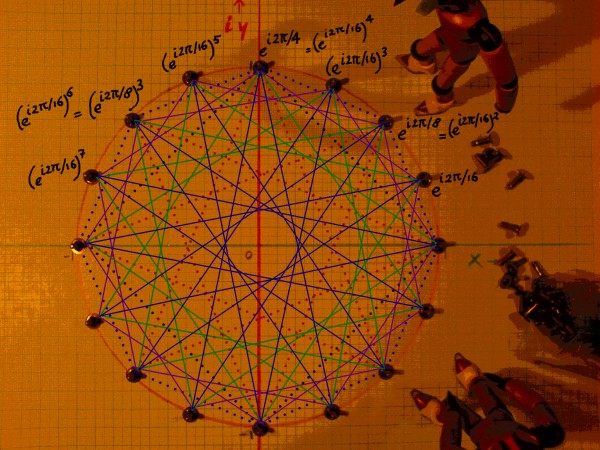 |
Continuing this pattern and multiply with the 32th
primitive root, would fill the spaces between the existing frequencies
again, resulting in a total of fifteen frequencies. Drawing that would
be a mess, so I decided to do another type of illustration. I made a
MaxMsp patch that can do these multiplications. It has a cascade of
five complex oscillators, going down till the 64th root of
unity, and four multiply-and-add procedures.
 |
Audacity's spectrum analyzer tells this about the outputs: 31 evenly
spaced frequencies, the first being around 690 Hz and the last one
around 21360 Hz.
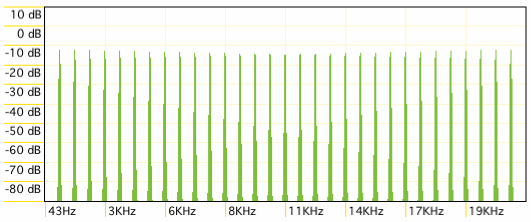 |
|
Real output and imaginary output have the same spectrum, but
their waveshapes differ. These shapes are remarkable
anyway. They are both approaching a pulse. That is no coincidence. A
pure pulse contains all frequencies (in phase), and here we are on the
way to that state. My page Quadrature
Mixing has more detailed plots of multiplied complex sinusoids. |
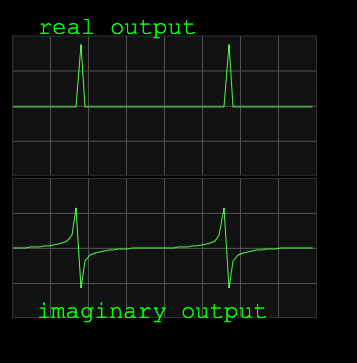 |
It was only a few minutes work to expand the MaxMsp patch with three
more oscillators: the 128th, 256th and 512th root of unity. Now we have
255 evenly spaced frequencies, starting at 86 Hz.
 |
My eight complex oscillators are at 86.13, 172.26, 344.53, 689.06,
1378.16, 2756.25, 5512.5 and 11025 Hz. These are octaves. The generated
frequencies are all harmonics from 86.13 Hz to 21964 Hz, 255 harmonics
in total. Not one single harmonic is missing.
The reason for doing this experiment was not because of the
beautiful sound. Hah! You would not want to hear it more than one time.
No, I was driven by curiosity. Roots of unity, and roots of roots of
unity, and roots thereof etcetera, are an essential ingredient of Fast
Fourier Transform. I just wanted to play around with it,
because it is quite abstract otherwise.
|
Wanna hear a Fourier kernel? |